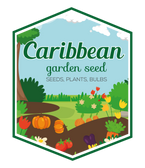
UBE Purple Yam ,Starter Plant, CARIBBEAN PRODUCT
- Get free shipping to lower 48 states on orders $54.95+ (Most Items), excluding live plants, plant bulbs, and black plastic nursery crate.
- Most orders are processed by the next day !
- Safe Seed Pledge
- Select your desired size and/or color from the available options.
Dioscorea alata, commonly known as purple yam, is a root vegetable with a stunning lavender color and goes by many names, including Edible Purple Yam, Filipino Purple Yam, Jamaican Moonshine Yam, and Indian Ratalu. It is highly versatile and has a delightful taste.
What is Ube Yam
Ube Purple Yam is a vigorous, fast-growing plant with heart-shaped leaves that can fill in spaces or cover unsightly structures in your landscape. It is easy to care for and thrives in USDA plant hardiness zones 6-10. Harvest and replant tubers each year to prevent overgrowth. This naturally occurring species of yam from tropical Asia is a popular dessert or dessert flavoring, and a dietary staple in Africa. It stands out with its vibrant bright lavender color.
How to Grow a Purple Yam
1 Install a sturdy, 8- to 10-foot-tall trellis along the edge of the bed to accommodate the purple yam vines. Or, create the bed along the edge of an existing structure such as a fence or shed. Using a shorter trellis is fine as long as you prune the vines regularly in summer.
2 Lean the tips of the vines against the base of the trellis to help guide their growth. Side-dress around each purple yam vine with a 2-inch-thick layer of compost once they are tall enough to reach the trellis.
3 Water purple yam vines deeply once a week. Run a garden hose at the base of each vine until the soil feels moist at a depth of 3 inches. Increase water to twice weekly during periods of extended drought, which will keep the tubers from dehydrating and splitting open.
4 Prune back the tips of purple yam vines if they outgrow the trellis. Snip off the excess growth with pruning shears and discard it. Make the cut just above a set of leaves to encourage side growth, which will give the plant a fuller appearance.
5 Pluck off and discard the brown, half-moon shaped bulbils that appear along the vines during the summer to keep the plant from self-propagating. Pull off the bulbils by hand and burn them or throw them in the trash. Do not throw put them into green waste cans or compost bins because they will take root.
6 Harvest the tubers for eating or replanting in late summer, once the vine has stopped growing. Dig up the tubers. Reserve some for eating and replant the others 2 feet apart and 2 inches deep in the same bed. Amend the soil with a 4-inch layer of compost before replanting the purple yam tubers.
In Containers
Plant a sprouted tuber slip in a large container set in front of a sturdy trellis or other support structure. If desired, set additional containers at 10-foot intervals along the support structure for additional yam harvests. Water the yams at least once a week -- and check soil moisture between watering sessions.
LET OUR CUSTOMER SPEAK FOR US

![[Seeds] - Caribbeangardenseed](http://caribbeangardenseed.com/cdn/shop/files/gift-card-gift-card-1_1024x1024_dfa857db-9150-4315-a362-7f0bb3fb9c47_60x28.png?v=1722895789)






